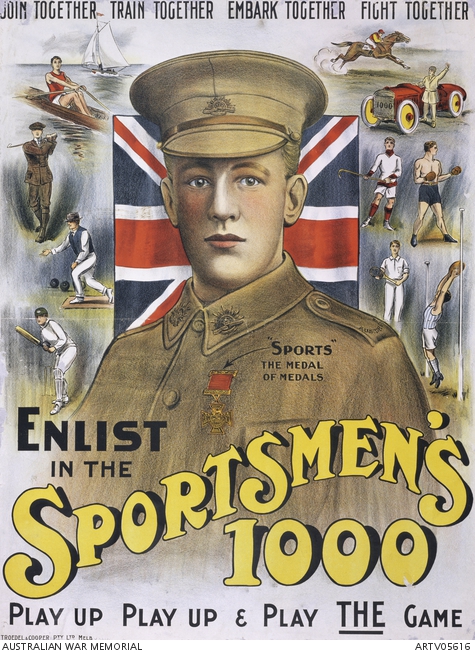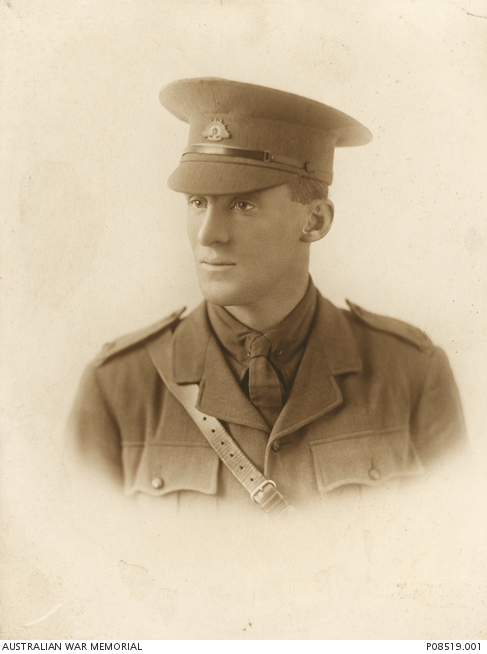Footy on the Front: AFL during the First World War
An outdoors group portrait of unidentified members of the Australian Rules Football Team of the 1st Australian Division.
The AFL Grand Final weekend has rolled around quickly, with the mighty Hawthorn Hawks tuning up to battle it out against the West Coast Eagles for the ultimate victory in 2015.
This perhaps inspires a timely look at the impact of the First World War on the game, through the unique perspective offered by the Memorial’s collections.
During times of conflict, sport found its place equally on the battlefield and the home front. Cricket, Rugby, Aussie Rules, Rowing, Surf Lifesaving carnivals – all were familiar remnants of home, potent and poignant reminders of familiar activities and the fun, mateship and joy of more carefree days. The qualities of grit, endurance, fortitude, physical strength and aggression have been considered as necessary on the sporting field as on the battlefield.
The onset of the First World War impacted upon the game of Australian football; whilst the Victoria Football League (VFL) was still competitive throughout the years 1914 to 1918, it was not immune to the adverse effects of war on a nation that was still developing politically, socially and economically.
Whilst the VFL considered suspending the season due to the onset of war, the game went ahead and the season commenced on 24 April 1915, with nine teams competing. The 1915 Grand Final went to Carlton, who smashed Collingwood by 33 points in front of a crowd of approximately thirty-nine thousand spectators. The spectator count at the 1916 and 1917 the Grand Finals were drastically reduced on account of the war; by comparison, these finals attracted crowds of approximately twenty-one thousand and twenty-five thousand spectators respectively. The lowest point of the competition during the war years was in 1916, with only four sides contesting the VFL – Carlton, Collingwood, Fitzroy and Richmond. The game soon revived, and by 1917 six teams were competing. By 1918 only the Melbourne Football Club was not playing the competition.
The most obvious factor affecting the game, of course, was the fact that many of the players enlisted in the Australian Imperial Force. Recruitment drives were targeted towards athletes, with many recruitment posters juxtaposing the importance of serving the nation against watching a football match.
ARTV05616. Australian First World War recruitment poster. Depicts Albert Jacka VC in front of the Union Jack flag. The Sportsmen's 1000 drew a direct link between sporting prowess and war, even punning that Jacka '
In early 1915, the State Parliamentary Recruiting Committee in Victoria released a vivid recruiting poster aimed primarily at young sporting men. The image juxtaposed an image of an Australian soldier standing guard over his dead mate with a photograph of a VFL match at the Melbourne Cricket Ground, suggesting where patriotic duty should truly lie.
ARTV07583 Recruiting poster produced by the State Parliamentary Recruiting Committee in Victoria.This poster was described by 'The Argus' on the 5th July 1915 as 'the first recruiting poster produced in Australia'. It was used by the Recruiting Committee as a means of shaming young men into enlisting by juxtaposing the image of an Australian soldier standing guard over his dead mate with a photograph of a Victorian Football League match.
Australians brought Aussie Rules to the battlefields of the Front as a means of escape and recreation. The most famous game was held at the Queen’s Club in London in October 1916. This display of the Australian style of football to the English attracted a crowd of 3000 spectators; whilst the English admired the fitness, skill and agility of the players demonstrated by the high marking, one news reporter preferred the “stoutness characteristic of the English game” to the “colonial exposition” he was spectator to.
The game was organised by Australian Olympic swimmer Lieutenant Frank Beaurepaire, and was in aid of the British and French Red Cross. The papers of Sir General Monash even contain a rare program pamphlet for the match, illustrated in the style of typical wartime cartoon humour by Cecil Hartt and Fred Leist.

The Prince of Wales was in attendance to watch the Third Australian Divisional team (who played with a large map of Australia on their blue guernsey) battle it out against the Australian Training Units team (who played in a red guernsey emblazoned with a white kangaroo).
Both sides were comprised of notable players of the day:
Third Australian Divisional Team
Lieutenant Bruce Moses Farquhar Sloss (South Melbourne), Captain
Lt John (Jack) Brake (University)
Dan Minogue (former captain of Collingwood)
Carl Willis (South Melbourne)
Leo Little (Melbourne)
William Isaac Sewart (Essendon)
J Pugh (Launceston)
H M Moyes (St Kilda)
P J Jory (St Kilda)
C Lilley (Melbourne)
L E Lee (Richmond)
Cyril Louis Hoft (Perth)
L Martin (University)
R Alley (Williamstown)
Hughie James (Richmond)
B H Mills (Brunswick)
J Foy (Perth)
Lt W Orchard (Geelong)
Australian Training Units team
Captain (Capt) Chaplain Charles Julius Perry (played for Norwood), team captain
John Thomas (Jack) Cooper (former captain, Fitzroy)
PC Trotter (Fremantle)
J Donaldson (Essendon)
H Kerly (Collingwood)
J Hoskins (Melbourne)
H Boyd
S C Martin (University)
H C Cosnvi? (Association)
C Armstrong (Geelong)
J Scullin (South Fremantle)
Malfield (Fremantle)
T A Paine (Northam)
E Beames
J Bower (Port Melbourne)
McDonald (Essendon)
Lieutenant Colonel Jackson (South Australia)
H Moore (South Australia)
Field umpires: Corporal Gray and G Barry.
Boundary umpires: T S Hewitt and E J Watts.
Goal umpires: Lieutenant H Olsen and S M Keen.
The Third Australian Divisional Team won the match against the Australian Units Training Units team 6.16 (52) to 4.12 (36).
The AFL has compiled records of the many VFL players who died whilst on active service; they have identified 104 players who died during the First World War. Of the game between the Third Australian Divisional team and the Australian Training Units team, three were later killed in the fierce action on the Western Front, only several months later.
Corporal Stanley Carlton Martin was killed in action on 03 May 1917 in France. He had played for University.
Lieutenant Bruce Moses Farquhar Sloss, who had captained the Third Australian Divisional Team, was killed in action in France on 4 January 1917, aged 28. He had been a star of South Melbourne Football Club and had been named ‘Champion of the Colony’ in 1911.
P08519.001. Studio portrait of Second Lieutenant (2nd Lt) Bruce Moses Farquhar Sloss, 10th Machine Gun Company, of Armadale, Vic.
Private Leslie Edward Lee was killed in action at Messines on 8 June 1917, aged 22. He had played for the Richmond Football Club.
H05990 Studio portrait of 224 Private Leslie Edward Lee, 10th Brigade Machine Gun Company, of Richmond, Victoria.
Other notable players, such as Collingwood’s Private Joseph Allen Cordner, were lost earlier in the war. Private Cordner was killed in action on the first day at Gallipoli, 25 April 1915.
P03483.009 Studio portrait of 180 Private (Pte) Joseph Allen Cordner, 6th Battalion.
There is a certain pathos in considering the differences between the game at home, and football played on a ground churned with mud and scarred by the heavy bombing of the Western Front. The heroics of the football match were ultimately of less consequence than the near misses of the battlefield. One Aussie, Lieutenant L.G. Short, wrote home to the Melbourne Argus in 1917 to vividly describe the true nature of footy on the Front:
“The playing field was within shell range. Every inch of it had been won from the enemy by the hardest fighting, of which evidence lay all around. The centre was marked by two enormous shell holes, with two shells (unexploded) lying beside a hand bomb at the bottom of one. Other shell-holes lay towards the goal posts… the look of players on the field would not have pleased the eye of an Essendon barracker, but they were just out of the trenches, where it is not possible to buy the shorts, shirts and stockings that make up the uniform of the footballer. Instead, the officers wore sheepskin jerkins, with socks over their pattern-less legs…
…but it is certain that the game had given them fresh heart. It had carried their thoughts vividly back to those happy days when football was played in certain Melbourne suburbs they called “home.” And it is in such happy thoughts and memories that we soldiers live.”
Melissa Cadden, Assistant Curator, Photographs Film and Sound.
Sitting on the trail of a 25 pounder field gun, 5/2486 Gunner (Gnr) (later Lance Bombardier) Brian Angus, of Northam, WA (right), shows off his newest acquisition, an Australian Rules football to his mate, 3/4516 Gnr Bob Finch of Poowong, Vic (left). Both men are with A Troop (A Tp), 105th Field Battery, Royal Australian Artillery (RAA), which is operating out of Salak North in Perak. Gnr Angus, formerly a hardware salesman, played Aussie Rules for the Avon Valley League back home and he is one of the few members of A Tp who plays in Malaya. He received this ball from the Hawthorn Football Club in Victoria, complete with the signatures of all the senior Hawthorn players. The ball takes pride of place in Angus's quarters and Angus says,








